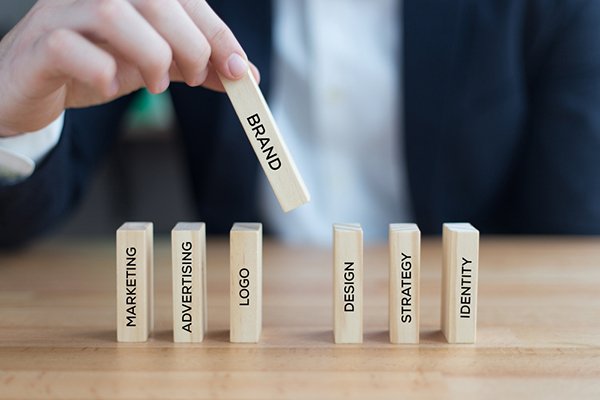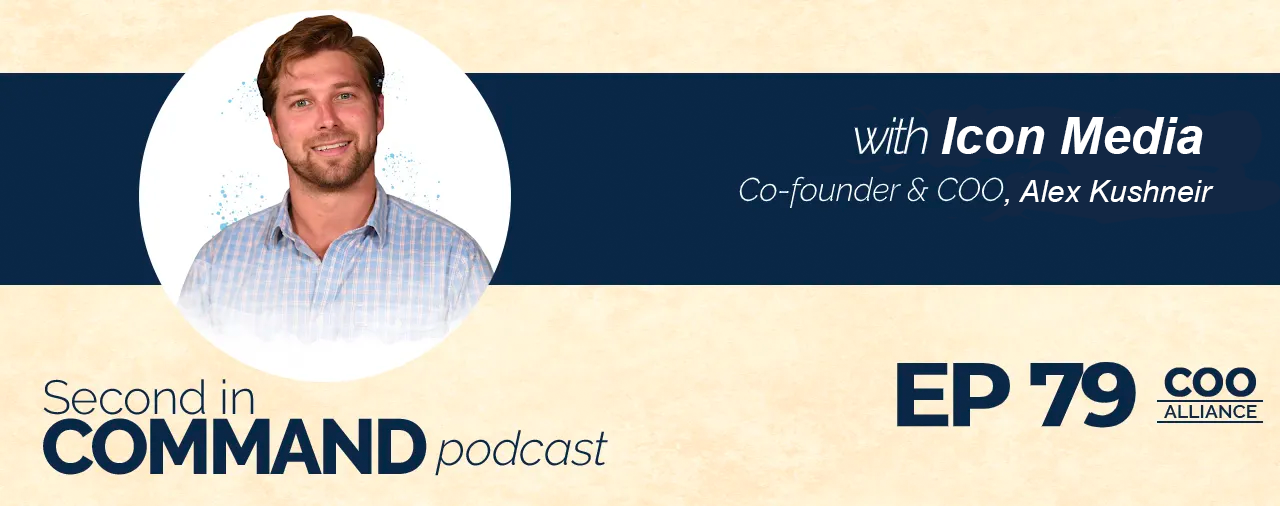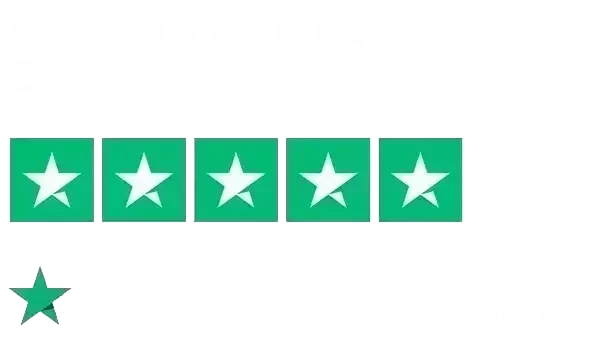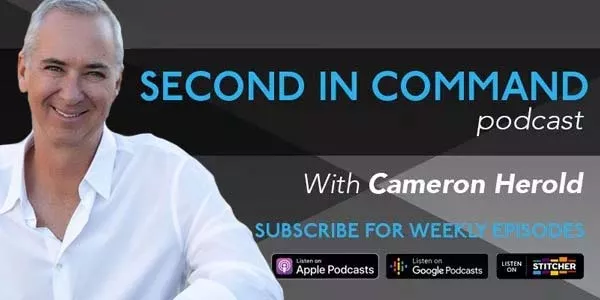Podcast: Play in new window | Download | Embed
Along with technological improvements, the way people consume digital media also evolves. When it comes to creating engaging video content, Icon Media is a company that surely has proven itself. Joining this episode is its Cofounder and COO, Alex Kushneir. He shares his experiences on what it’s like to be a COO in a video production company and how to run it as smoothly as possible with your CEO. He talks about the meta for videos in engaging with people through social media and goes into the details of how you can create content with a positive impact on your consumers. Alex also touches on the personal traits and characteristics you need to work on if you want to get into the industry.
Resources:
Connect with Cameron: Website | LinkedIn
Get Cameron’s latest book: The Second in Command – Unleash the Power of Your COO
Subscribe to our YouTube channel – Second in Command Podcast on YouTube
Get Cameron’s online course – Invest In Your Leaders
—
Alex Kushneir is the CEO and Cofounder at Icon Media. He started in production and has worked his way up in a few years. During those years, Alex established himself as a power host producer in meaningful education programming at companies like Cheddar, ABC, NBC, and Al Jazeera. He also produced special projects for the World Economic Forum, the 2016 DNC in Philadelphia and The Reclaim Series Campaign, which brought awareness to the world’s food and fashion waste epidemics for the Huffington Post. In Icon Media, he continues to create conscious content that is educational, entertaining and overall making a positive impact on millions around the world. Did I mention that Icon Media has a social media distribution of their videos to over 30 million people? Alex, welcome to the show.
Thanks for having me. I appreciate it.
I started this show because I always wanted the rest of the story. I was thinking about my mom and dad one day and I thought, if you asked my mom how she raised her children, she’d have a true story. If you asked my dad how he raised the kids, it would be a true story. They’d be completely different and yet they raised us together. I’ve always wanted to know the second in commands’ insights on how they grew the company and also how you operate in that role.
Do you want to give everybody a little background about me? I can do it. I can tell my story a little bit.
I want you to tell us a little bit about you but before that, tell us a little bit about Icon so we understand them as well and go back and tell us your story.
My business partner is a social media influencer by the name of Jay Shetty. A lot of people know him. He is a great business partner and a great friend. Icon Media is a creative production agency that creates positive impact video content. These videos are going to leave a person, environment, society, heart, mind, body and soul in a better place. That is the focus and the reason why we created this company. We saw that there are so many entertainment and production companies, but not solely focused on creating good and what I call positive impact videos and that’s what we do.
How did you get involved?
A little bit of background about me. I studied film and digital media in college and did that in my career, which a lot of people don’t do. I’m one of the rarer people coming out of school. I was a former athlete as well. I played Division I college football in the Big 12. That instilled a lot of hard work, grit and character, which is why I elevated my career pretty fast. For nine years, I worked at NBC, Universal, ABC, Disney for Katie Couric, Al Jazeera, which is to me from a journalist’s point of view, Al Jazeera does some of the best hard news coverage globally. A lot of chops were had there. I went to the Huffington Post to create digital content in the motivational, inspirational and positive impact space. Lastly, I worked at Cheddar which is an OTT network started by Jon Steinberg. He was the President of BuzzFeed and started an OTT network over the top network. They’re now doing traditional broadcast deals as well and they sold for about $255 million. John did that in about four years but that was the last place I was at.
When I was in the Huffington Post, I met Jay Shetty. No one knew who he was. Maybe he had 20,000 to 30,000 followers. I was brought in as a digital producer to create a positive impact vertical called HuffPost Rise. I was a producer. Jay was a host and talent. He was doing interviews with authors like Deepak Chopra and such. We were doing great work there at HuffPost in this vertical. What we found was that the vertical of positive impact, wellness, mindfulness and consciousness started to outperform every other vertical that the Huffington Post had. Whether it was their news, comedy or sports vertical or whatever, the HuffPost Rise was getting hundreds of millions of views in the year that we there. I alone did 250 million views in the content that I produced. I produced over 25 videos with one million views or more.
We were like, “People are hungry, especially on social media for these types of content.†This is before Instagram. They haven’t been fed it before, now we’re feeding it to them and they love it. That’s when we got a sense of that and it was cool. Fast forward about 1.5 years, Arianna Huffington exits the Huffington Post and starts a company called Thrive Global, which is a corporate wellness company. Jay and I both left and I went to Cheddar. In that journey of while I’m at Cheddar and Jay Shetty is focused on building his career, he does a lot of speaking and video content. He gets introduced to an author by the name of Gabby Bernstein, a New York Times best-selling author and wonderful person.
She takes notice of Jay and starts seeing that Jay is going about a million followers a month organically on social media. It was 1 million to 1.5 million, which is insane. She basically says, “Jay, I see you’re doing some amazing things on social media. Your growth is ridiculous. Can you create a video for me?†He did and the video did absolutely amazing. It did 9 million or 10 million views and 100,000 shares, which is probably the biggest thing you can look at when you’re looking at a social media video. It’s the engagement and a guru following of maybe 50,000 new followers for that one video.
What happened was that Jay reached out to me and our friendship remained throughout when we weren’t even working together anymore. We would have these side projects we’d work on together and talking, “How can we work together again?†We enjoyed it. Finally, it happened. A man by the name of Tom Bilyeu, one of the Founders of Quest Nutrition reached out to Jay. Jay reached out to me and Tom said, “Can you create content for me for my Facebook page? I want to get to over one million followers.†Jay reached out to me. He’s like, “We work together at Huff Post. You’re my good friend and I know the type of producer you are. Do you want to start a company together?†I’m like, “Sure. What do you have in mind?â€
We talked about it and we finally reached a deal with Tom. I started working on it and I’m like, “I’ve got to quit my job because it’s too much work to create eight videos and produce them while working a full-time job in the field and branded content production for another growing startup,†which Cheddar was at that time. When I started, I was the 40th employee. When I left, there were maybe 120 employees. I was there for about two years. I left Cheddar. I told Jon and my direct boss that I’m going to leave and start my own company with Jay Shetty and they go, “Are you sure? You’re crazy,†maybe a little bit. I felt it in my heart.
That’s what I thought. It felt right and good to my core. Leaving and going to do this company felt so good. I lived in New York City. This is all in New York City and Jay goes to me and said, “By the way, I’m going to move to Los Angeles with my wife.†I’m like, “No kidding.†I had to literally quit my job and start a company and I don’t know anything about business. I start at a company with myself and one client and moved to Los Angeles. In a year and a month, we were doing multi-million in revenue. Between Jay’s personal team and the Icon team, we have fourteen full-time staff employees. It’s been accelerated and blessed growth. I think that when you build something and the foundation of a company to do good and to help people, crazy things start happening and that’s the way it’s been since we started the company. I didn’t have full-time employees until I started hiring and reinvesting into employees, gears and technology and finally, into the sales and business development team. That’s where we are now. That’s the foundation story of Icon Media.
What’s the future of Icon? Where do you think you’ll be in three years? What are you building?
In the future, there’s always going to be this vertical within the company that’s going to create social media content. People are always going to need great social content for every single new and emerging social media platform, whether it’s WhatsApp, Instagram or TikTok. That vertical always exists. Clients will always need that type of content. What’s going to happen is we’re going to have that area but then we’re going to have another vertical of creating documentaries. Also, maybe short-form series that’s going to be separate from social media. I know that Facebook has its long format genre so we can always go with them or YouTube Originals. It’s moving into the Netflix and Amazon Prime stuff in creating documentaries. Lastly, I would love to create feature-length films in the educational entertainment area.

Positive Impact Video Content: There’s so many entertainment and production companies, but no one focuses on creating good and positive impact videos.
That’s the growth. We’re taking our content one year and one step at a time, increasing production value, the type of writing and reach we can have, not only on people on the viral formats but into larger formats. That’s a big goal. We’re also creating brands within the company. We’re creating brands that we own and operate that build a foundation on their own in different categories, whether it’s women empowerment, environment, healthy eating habits, and food or healthy entertainment and pop culture. It’s creating those brands within Icon that we own and operate that build an organic following. That’s the focus.
I love that you mentioned how strong Al Jazeera is. I’ve always loved the Al Jazeera network. I was interviewed years ago on their TV show. It’s on one of their TV news shows. With Huff Post, you talked about the vertical of wellness was that biggest vertical. Do you ever think that there are going to be news networks that are purely focused on the good and stop with the whole, “If it bleeds, it leads?â€
The big ones will never change. They’ll have divisions within them that will have those. The CNNs and Fox News of the world and so forth will always have that mentality.
CNN is only a few years old. I wonder if we’re ever going to have a new network startup that could compete against them that refuses to cover the latest hurricane, the war in whatever, the plane that crashed and the guy that was a pervert. When people are starving for all this wellness and good news, I wonder if we can ever get to that stage where we don’t need to consume that stuff.
Jay uses and told me this analogy, “If all you serve people is junk food, that’s all they’re going to ever know.†All they’re going to know is junk and that’s all they’re going to want until you can bring in a new type of food, a healthier option they won’t know. You need to create it. Someone needs to create whether it’s us or someone else. If you create it and give it to them in a way that looks appetizing and they start consuming it. That tastes pretty good. I like that. I like how that made me feel. It was pleasurable to the eyes, soul, body and mind. The mind is powerful. Absolutely, it’s possible. You need to create something that is going to feed that hunger within all of us.
A lot of people and probably you’re included in this, “I’m tired of watching that same nonsense every single day.†There is a time and place for everything. If there’s an option out there where I can come home and there’s some good news on because there are a lot of people doing a lot of good things globally. No one’s packaging it the right way in the formats and platforms. If you can do that, that’s a home run hit. There are tons of brands and people that want to get involved. The energy you create from, it is going to be something positive and it’s going to help people. It’s going to make what I do making positive impact content, pop culture.
We’re seeing it in pop culture now where there’s this huge genre that is so powerful, strong and growing so quickly. It’s proven there’s a market for it. Now, it’s almost like people have got to take a swing at it. Talk to me a little bit about some of the experience that you pulled over the years that is helping you in the COO role. You’re also cofounder of this. Are you operating partially as the entrepreneur and partially as the COO as well or are you more the second in command visionary on this?
This is where I’m all new. I’m definitely a creative mind. I was a film and digital media major so I always had a creative mindset. I’ve been fortunate enough to have Jay who’s creative but also business savvy. He understands that side of things and helping me in my decision-making. I am the COO but also making day-to-day decisions. I’m here every day at the office working with all of our great employees. The biggest thing as an athlete is I’ve always been that natural leader. I was always the captain of the teams. Even amongst my friends’ group, I was always the guy having to organize and make the decisions. It’s the natural and organic way that my life has gone that route and always learning and asking a lot of questions into things I don’t know. Being kind to people as simple as that may sound. I never went into a job with ego from the first job to the last job when I knew more in those years I had as a producer.
Having that skillset of knowing traditional broadcast digital content, OTT, pre-production, production, post-production, how that workflow works, what pricing looks like when you’re hiring a director of photography, gaffer, sound engineer or an editor. Knowing all these different things allowed me to start this company because I knew how much those things would cost. I know how much production would cost. Where Jay came in and helped a lot is the growth strategy, direction and the pivoting of where we need to focus the company growth and the direction.
It’s been that balance of having a business partner that you can rely on to have super open communication with. We literally talk about anything and everything. If I screw up, I don’t have an ego so I’m like, “I messed that up. I didn’t make the deal. The deal I made wasn’t the right deal or this or that and vice versa.†I will still be the first to admit if he made a mistake as well or I forgot that. Having that raw open communication with your business partner is so important and that’s added to a lot of growth and opened us up as a company.
You’re also playing the second in command to a fairly strong personality and visible leader. When I was building 1-800-GOT-JUNK? everyone knew Brian and not many knew me as the COO. Do you find it hard at times to see them there?
I am the COO, the second in command because Jay is making the top-level decisions, but I’m always there learning and talking with him. He’s got 35 million followers on social media and I may have 1,000. I’m inactive on social media. It’s the way I choose to run my life. In real life, people are like, “You’re so sociable and talkative.†At a party, I’m the one who’s talking to everybody and entertaining people were Jay is probably a little more reserved. He’s out with a lot of fans with the things he does on social media, the content he’s creating and all the amazing things he does. In the real world, we balance each other out well to the social networking world of things. It is a balance.
I’ve always had a big personality and been that way. If I have something to say, I’m going to say it and if he has something to say he’s going to say it. It’s like, “Execute on it and it’s done,†but it’s never been a thing where I felt less or not as equal. It’s always been that we’re on the same page on the same level. It’s open and honest and we talk about it, hash things out and create things. Whenever we come up with something new, it’s got to be 50/50. It’s not your 80% and I’m 20%. It’s never that.
It’s interesting, the COO’s job is to make the CEO iconic as well. The community always looks up to the CEO and it’s our job to make them iconic. Their job is behind the scenes to ensure that we’ve got everyone understanding that we have to make the tough decisions and we’re still an amazing person. It’s like, “Come on, Alex is amazing. He’s not a jerk. He had to fire two people, but I would have done the same.†Their job is to keep us propped up internally and our job is to prop them up externally too. Do you ever argue or debate?
We don’t know if we argue. I would say we debate. It never comes from this negative place. It’s always like, “Let’s talk about it.†We never raise our voices and it helps that Jay meditates two hours every single day, every single morning and I’m a pretty calm person. I like to be happy and joyful. I go to nature a lot and meditate in nature. We always come from this place. We get frustrated and maybe a little angry but then it’s like, “Let’s breathe. Let’s think about it. How can we solve this issue?†When you come from a place that’s like that, you can solve a lot of issues a lot quicker and in a better and more efficient way. When it’s like water and you can converge and combine. You get so much more done. It’s simple to me but I know that’s not true in a lot of cases.
It sounds like you guys are aligned with what your core purpose and mission are and core purpose and vision of what you’re building as well.

Positive Impact Video Content: The number one for creating creative content is providing a story.
Absolutely. That’s important. Having an open communication on when someone’s thinking something else and that’s definitely happened between Jay and I. It’s like, “You were thinking that?†I was like, “I wasn’t thinking that way but now that makes a lot of sense. Let’s start integrating that idea or thought, the way we’re pitching something, developing something or thinking about the way we’re operating.†When one of us explains it to each other and it makes sense or we debate about it, “That’s cool but what if we did it this way?†It’s open and honest communication about what we’re thinking and feeling about whatever it is within the company.
I love that you mentioned that you were always the captain of the teams and a bit of a natural leader. I was telling someone that when we’re recruiting and interviewing people, we need to look for those early-stage leadership traits or moments as well. People aren’t going to know if they’re good leaders until they’re in their 30s. I’m like, “No.†I was the top cub, the top guy at the church or the captain. You can see leaders in the young stages of people’s lives. Do you guys look for leadership at this early stage? What are you looking for in the behavioral traits that people you’re hiring now? Not the skills but the actual behavior traits?
That’s one of the biggest things when we started hiring full-time staff employees. The culture we wanted to build here was always a place that I wanted people to come into every day where they felt comfortable and they were happy. Anytime you have a startup, it’s going to be somewhat stressful and it’s going to be hard work. You’ve got to know that coming in because it is a lot of work to have to start a company out of nothing and develop it, build it and have continued positive revenue. That’s going to be stressful and hard work even though it comes from a place of good and I make great content that helps people that’s going to happen.
When I hire these people, I’m aware and conscious of people’s energy and the way that they present themselves, how they speak and how they feel. Sometimes it’s hard to describe but it’s how they feel when you’re having a conversation with them. You’re sitting next to them side by side and you’re looking into their eyes and they’re looking to your eyes, not in a romantic way, but understanding where they’re coming from. They’re smart, knowledgeable but they’re good people. There are good people that want to work hard for you.
I would say 90% of my employees have come from either big companies, big production companies, Fortune 500 companies that get burnt out. They’re like, “I’m tired of this grind. I’m tired of that the energy that that office has.†She went to New Zealand for two weeks and she came back. She was like, “I was excited to come back to work and I’ve never felt that way in my twelve-year career.†I was like, “That’s awesome.†That’s the place I want to provide you with to come to every day with the people that you like and you enjoy your job. It’s something new and different. It’s going to be hard work, which excites people. If you’re good at what you do, you’re like that. You’re like, “I like the challenge.â€
A-Players want hard work. C-Players run away from it, but for A-Players, that’s what they’re looking for.
It’s like, “Let’s figure this out. How do we get better at what we do every day and help each other?â€
It’s like an athlete. If you’re an athlete, you don’t go to the gym and fluff your workout. You go and you want to get sweaty, work hard, you want the muscle to hurt and then you leave and go, “That was awesome.†A couch potato goes in and they’re like, “I’ll get on the bike for 30 minutes. I’ll read my book while I’m there.†That’s not a workout. You might as well stay in bed. Are your employees remote? Are they all out of one location or do you have a bit of a blend?
In the beginning, I wanted to build a company where everyone is here in a physical office. We’re located in West Hollywood at the Pacific Design Center in this beautiful building. We wanted a beautiful office because we wanted people to come to a place that felt good in general. That’s how we were personally. I don’t think every company has to be that way. It depends on the company and what they do. We’re hands-on because it is a creative production agency where we have producers, writers, editors, social media experts and now we are adding our sales division. Everyone is in-house at the office. They come in every day unless they’re out filming or doing their thing. We also have Jay’s team working on all Jay’s podcast stuff, videos and all that stuff. I wanted that internally. I will say though, I have some great salespeople that I know that live in New York or Texas and that’s where their families are. I get that they’re not all going to move to LA for this job but I wanted the person who’s going to develop our Sales Division or Business Development Division to be internal because I work closely with them.
You want your core to be close to you.
Once that is established and we get something running and generating like the salespeople, I would love to have two people dedicated in New York City to take meetings. It’s important to have people in New York and Los Angeles and have them come and train for 1 or 2 weeks and all they do is work remotely. It depends on what you’re doing. I have a cousin who owns a communications and technology company and a lot of his employees are remote because he doesn’t need them in the office every day. It depends on what you’re doing.
I still grapple with that. My whole team is remote. A few of them happened to be from the same city but they’re remote. In fact, we’re running an event. We run the only network of its kind in the world for seconds in command called the COO Alliance and my team is actually flying in because we’re having an event here in Vancouver. One of the guys I thought he lived in Texas turns out he lives in Virginia. It doesn’t matter. In my prior worlds, all of it was culture. It’s interesting how do you build that culture-like environment when you are remote. It’s cool that you guys are trying to stay with a core for now. This is a bit of a selfish question. Can you give us the top three tips to have great engaging social media video content for anybody reading that does that? Maybe we’ve got 1,000 or 10,000 followers or whatever where we’re doing it to our employees or customers. How do we create great engaging content?
The number one thing especially for what we do is the story. Even if it’s a company, a personal brand, a product, what is the story behind that? Is it emotional? Is it powerful? How does it make the audience feel after they watched that piece of video? Are they crying? Are they laughing? Thinking about those things, what emotion are you developing? If it’s going to make you emotional, chances are it’s probably going to make the people watching emotional. I would say that’s probably the number one thing to me. What’s the freaking story? Tell me about that. Tell me about the characters.
I started doing this with a lot of my writers and producers. When we introduce a character into a story, say it’s a recreation of an event, I go, “What’s that person’s backstory?†I know the audience will never know it but I said, “You should know what their backstory is. Why are they feeling that way?†“It’s because their father was an alcoholic.†I’m like, “There you go. Now you’re creating a character.†You know it but we don’t necessarily need to have the audience know that. We need to know that because it’s going to make that character, the actor performs better and also it’s going to add a lot more to the actual reasoning behind the story in general.
Thinking about that stuff that is important to me and it helps a lot. Production value is one of those things where you don’t need to create high-end production in order to have something super engaging on social media. I’ve done Skype interviews. I interviewed the person on Skype. I already shot B roll of whatever it was, cut it all together and made the opening of the video powerful and engaging with a great headline. The video does ten million views and 250,000 shares. The production value doesn’t necessarily correlate with engagement that’s not true.
I will say this that if you do have higher produced video content that still looks good. It can be shot, cut and edited well. That will give you more value add because what you can do with that is not only posted on social media platforms but you can use the video. Let’s say you have a new book coming out and you’re trying to get on more podcasts, you want to go on the Today Show, you want to go on so-and-so and people want to know what you’re all about or what the book is all about. If you have some high-end content that you can show off what you’re about or what the book is about, they’re like, “I get it. That’s good.â€

Positive Impact Video Content: People need to know that consumers are conscious and aware of where their brand aligns. People pay attention, and people want to know.
You’ve got to have that fair balance of high-end production value, emotion, storytelling and getting the audience engaged at the top of whatever you’re creating is the third. I mentioned it in there but at the top of your video in the first 3 or 4 seconds, you need to grab the audience attention by saying or seeing something profound. We all know people click through their stories and feeds and as a lot of people, young and old, my dad is on social media. He’s 61 and I have cousins who were thirteen on the same platform or a different platform. Their attention spans are short. They’ll look at something and they’re like, “I’ve got to click on it.†Titles are important. Those are my biggest ones.
Thank you. I did a quick Facebook Live before I hopped on. I was having this raw moment. I dropped my oldest son off at university for his first year. We moved him into a residence and got his room all set up with them and it’s hard. I’ve worked my whole life to get him up and out the door and now I’m like, “When are you coming home? When am I going to see you?†I ended up with tears in my eyes at the end of the video talking. I was sharing what it felt as a parent to be doing that stuff.
That’s real authenticity which everyone appreciates. It’s captured so well on camera. It’s hard to fake your emotion on camera and people pick that up right away.
Those ones are almost easier to do raw when you’re sitting on the couch sharing a moment. The hard ones to do are the ones that Jay does, which are more of the positive, uplifting and motivational. How do you pull that energy and that lighting in that story? That’s cool. How about some struggles? Where are you struggling with your career as a COO or coming into this business as a COO?
The biggest struggle is hiring great salespeople. We are a company that does come from this positive space and I don’t want people coming for the money, even though I was like, “Abundance will come and it’s going to happen.†Also making sure we’re working with people and businesses that are also aligned with what we stand for at some level. We haven’t worked yet with a large scale company because we’re still so new. Let’s say, Johnson & Johnson. I know that not everything they do is going to align exactly with what we stand for. At the same time, where is that give and take. It’s like, “I’d love to work on this project about gender equality with Johnson & Johnson.†They’re doing a huge campaign about it. That is something that I’d be attracted to.
It’s making sure to find the right people. That’s been a hard thing is finding the right people in a certain area of a company that you still want to be good people and not being about one part of it. That’s been hard. I’ve finally found that person which I’m excited for. The other pain point is yet finding people in companies that are also aligned with us. That’s starting to shift. A lot of people, especially brands need to know that consumers are conscious and aware of where the brand aligns, either with the environment, how products are made, who they are, what they stand for, the social causes that they align with. Brands need to think about that. People pay attention and they want to know.
That’s been a big shift. That’s been exciting. That’s the biggest pain point and continuously making sure that you’re executing on a high level. I have friends who are entrepreneurs and businessmen and women. I started it literally in my apartment and now we have fourteen employees and this is when you get hit a little bit. You’re going to get knocked out a little bit. You’re going to take punches. It’s going to happen. That’s life. Things happen and you can either be like, “This is tough and it’s going to be hard,†because it is. There are hard weeks where you’re like, “I want to go back to the easy job. Can I work for Cheddar that sold for $50 million and have a nice cushy job?†That’s easy compared to starting your own company but then it’s like, “I love this and I know what it can be and what it can become.†That’s so much more fulfilling. You’ve got to put your big boy pants on and take the punches and stand back up and get back up. When you’re being honest with people and raw with them, they can feel your passion, “This guy is passionate about this.â€
What punches have you taken? Where have you gotten hit?
It’s when we’re executing because we’re so used to executing at a high level.
Give me a specific example.
A client comes to us and a video didn’t reach one million views which is hard to do but we did put it on such a high level of doing that. To me, 400,000 views are good which is great to think about. When we don’t execute on that high-level, a person or a client a partner might be like, “What happened to this video?†That’s one of the biggest things. It’s probably on me on getting them to understand the value of what we’re providing them with all the production, storyboarding, writing all this and coming in like, “I don’t know if I’m happy.†What was the value in creating, let’s say four videos but you gained 50,000 followers from four videos? That’s huge. So-and-so got 400,000 followers from eight videos and I’m like, “That’s hard to do. I’m sorry, they didn’t feel that way.†Those are some of the biggest things. Sometimes it’s on you, especially when you’re starting because you execute it on such a high level and the other three people were here, but in reality, it’s still good and you show them what is possible and they didn’t quite get there.
One of my books called Free PR and I taught people the secrets on how to generate largescale free publicity. We were on Oprah at 1-800-GOT-JUNK?. We did a six-minute piece on Oprah. We landed 5,200 individual stories about our company in six years and that was before Facebook existed. We had nowhere to amplify it. We couldn’t even share the stories but they’re like, “You were on Oprah. That must have blown the doors off.†I’m like, “No, not really.†The phone rang for 24 hours and it stopped every other day. It’s about managing those expectations and how to deal with it is a critical lesson for sure. If you were to go back to the 21-year-old Alex Kushneir who’s starting off in his job or his career, maybe you’re 22 and finishing college, what advice would you give yourself that you now know to be true?
I’ve been pretty good. I would say and this is probably one of the things that a lot of young, hungry people are passionate about whatever it is they’re doing. Be patient because time flies by so fast. I remember that I was 22 when I graduated from college. You’ve got to be humble and know that there are a lot of smart people that have done it before you and they want to help you. Listen and learn from them, be patient, because I know you’re going to want to crush it like, “I want to be a millionaire. I want to be successful. I want to do this and do that.†That’s going to come. In nine years, you can have your own company and you can do whatever you want.
Putting the groundwork and become an expert at what you do and you can talk about it so clearly and people are like, “He worked for some big companies and did cool stuff. He’s done hundreds of millions into the billions of views on social media with the content he’s done.†I put in some groundwork. That’s the biggest thing with people coming out of school or not. Work the industry you want to develop, thrive, learn, and develop your skillset in different areas. I’m developing mine in business. I’ve never studied business before but I’m definitely getting better at how to operate, manage teams and people and so forth. That’s my biggest thing. Be humble, be hungry and educate yourself.
Also, be patient. I don’t know who it is that said this quote first but I’ve always said it takes a long time to get to the night before you become the overnight success story. You’ve put in the nine years to become the success. Alex Kushneir, the Second in Command, COO with Icon Media and Cofounder. Thanks for sharing with us on the show.
Thanks for having me. This was fun and I hope I did a good job of explaining every question that you had asked me.
You did well. Thank you.
Important Links:
About Alex Kushneir
 Alex started in production and has worked his way up in just eight short years. During those years, Alex established himself as a powerhouse producer in meaningful, educational programming, at companies like Cheddar, ABC, NBC, and Al Jazeera. He also produced special projects for the World Economic Forum, the 2016 DNC in Philadelphia, and the Reclaim Series Campaign, which brought awareness to the world’s food and fashion waste epidemics for The Huffington Post.
Alex started in production and has worked his way up in just eight short years. During those years, Alex established himself as a powerhouse producer in meaningful, educational programming, at companies like Cheddar, ABC, NBC, and Al Jazeera. He also produced special projects for the World Economic Forum, the 2016 DNC in Philadelphia, and the Reclaim Series Campaign, which brought awareness to the world’s food and fashion waste epidemics for The Huffington Post.
At Icon Media, Alex continues to create conscious content that is educational and entertaining and overall making a positive impact on millions around the world.
Oh yeah, and did I mention Icon Media has social media distribution of their videos to over 30 million people!





